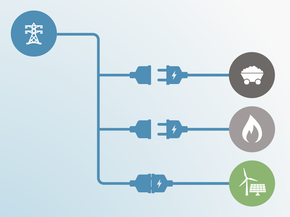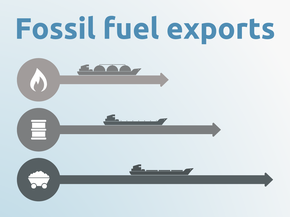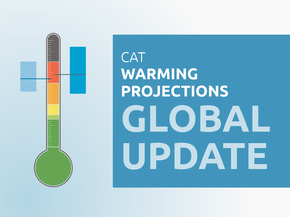Current Policy Projections
Economy-wide
According to our assessment, Mexico’s current policies will lead to emissions of 724 MtCO2e excl. LULUCF in 2020. In 2030, the emissions level is projected to be between 844 and 852 MtCO2e, excl. LULUCF. We estimated a range as we consider it unrealistic that Mexico will achieve its target of 7% nuclear electricity generation in 2030 (lower end) and it is uncertain which electricity source would be used to fill the gap. If instead of nuclear generation, gas was used, Mexico would have higher emissions by 2030 (upper end). This scenario suggests that Mexico will not meet either its 2020 or 2030 emissions targets, and will need to implement additional policies to do so.
Historically, Mexico’s emissions have been increasing since 1990. GHG emissions have increasingly shifted away from agriculture and LULUCF towards energy-related emissions. While in 1990 agricultural and LULUCF emissions represented almost 27% of Mexico’s GHG emissions, by 2012 their share had declined to 15%. Over the same time period, energy-related emissions increased substantially—by more than 60%.
The basis for climate policy in Mexico is its ‘General Law on Climate Change’, which translates the overarching targets into strategies and plans, and provides the institutional framework for implementation. The law does not include concrete political instruments, rendering it impossible to quantify its direct effects.
The National Strategy on Climate Change (NSCC), published in June 2013, implements one of the requirements of the General Law. The NSCC is designed towards a long-term strategic development, but only provides very general guidance. How this will be translated into concrete action remains to be seen.
The 2nd Special Programme on Climate Change (PECC 2014–2018), published in 2014, includes the most relevant mitigation measures to 2018. The programme summarises 23 quantified mitigation-relevant measures that lead to a reduction in emissions by 83 MtCO2e in 2018 compared to the baseline presented in the same document. The PECC will end in 2018, and so far Mexico has not announced plans to renew it.
In 2014, Mexico implemented a carbon tax that is set at approximately at US$3.5/tCO2e differentiated by fuel type (SEMARNAT, 2014). This tax is expected to generate an annual revenue of about US$1 billion. However, its impact on GHG emission reduction is unclear and, given its low rate, a substantial emission reduction is unlikely.
In 2017, Mexico began a simulation of a voluntary Emissions Trading Scheme. The General Climate Change Law (LGCC in Spanish) was modified later that year to make the scheme mandatory as soon as its three-year pilot phase starts in August 2018. The formal start of the ETS is planned for August 2021, together with the entry into force of the Paris Agreement (Secretaría de Medio Ambiente y Recursos Naturales, 2017). Between 400 and 700 companies are expected to participate in the market (Santiago and Rodríguez, 2017).
Energy supply
The Energy transition law (Camara de diputados del H. congreso de la union, 2015), published in December 2015, includes clean energy targets for Mexico for the year 2018 (25% of generation), 2021 (30%) and 2024 (35%). Clean energy according to Mexican law includes renewable energy sources, nuclear power, CCS as well as efficient co-generation (Secretaria de Energia, 2014a).
The inclusion of the latter technology is particularly noteworthy as co-generation plants are mostly gas based and thus emit CO2. While this technology currently does not play a role in Mexico, the latest Energy Outlook published by the Mexican government (SENER, 2017b) suggests that the share of co-generation might grow to 5% of total generation in 2030. This implies that the share of zero-emission power plants might be lower than what the Clean Energy Target indicates. For instance, for 2024 the projections foresee a share of 5% of co-generation in the electricity matrix, potentially lowering the share of zero emission power generation under the 2024 clean energy target to 32%.
In the same electricity projections, 590 MW of coal-fired capacity is added between 2018 and 2020. The projections suggest that coal-fired generation will peak in 2024, and be reduced by 16% between 2025 and 2030 (SENER, 2016).
The current Energy Outlook also projects lower nuclear generation by 2030 than previous versions. Due to the changes in coal and nuclear projections, the updated emissions are larger than previous CAT estimates. Nevertheless, the Energy Outlook states that nuclear electricity generation will still grow to make up 7% of generation in 2030 (compared to 3.6% in 2016). We question whether this will happen given the lack of long term planned funding (Valencia Juliao, 2017).
There is currently only one nuclear plant operating in Mexico, the Central Nucleoeléctrica Laguna Verde. The plant was constructed to house five reactors, but only two are operating. The Mexican government has commissioned preparatory technical studies to install two further reactors, which could be built at the Laguna Verde plant. However, the Sub-secretary of Energy indicated that each additional reactor would require over a billion dollars of investment, and that the next federal government (elected in 2018) will need to make the investment decision (Valencia Juliao, 2017). Should Mexico choose not to invest in additional nuclear capacity, but rather increase generation from gas-based cogeneration, its emissions in 2030 would be 8 MtCO2 higher. However, Mexico could invest in additional renewable capacity instead, achieving the same emissions reductions as with nuclear.
Mexico intends to use a combination of clean energy certificates (Secretaria de Energia, 2014b), measures to support clean distributed generation, and a tender scheme to help reach its clean energy target. The clean energy certificate scheme will include targets for both electricity suppliers and large consumers (those with a load larger than 1 MW), and the tender scheme aims to procure new capacity in a competitive manner. However, both instruments are too young to judge whether they will be effective in achieving their stated aims.
Preliminary results are promising, showing that the tender might be especially effective in increasing the share of renewables, especially solar and wind, as a large number of projects were awarded, with record low prices (SENER, 2016; Centro Nacional de Control de Energía, 2017). However, the status of the projects resulting from these three tender rounds of electricity auctions is not clear. Currently, there is no governmental overview and the information on single projects is only available through the media.
In December 2017, Mexico’s Secretariat of Energy announced that the Villanueva 3 solar PV park of Enel Green Power Mexico had started commercial operations, becoming the first winning project from the country’s first long-term power auction to feed power into the national electricity system (SENER, 2017a). Villanueva 3 will gradually reach a capacity of 250 MW. According to the media, El Cortijo wind farm was the first project from the first tender round to begin construction in 2017. This project is expected to start operations in the second half of 2018 (ACCIONA, 2017). In June 2017, the Asociación Mexicana de Energía Solar (Asolmex), which was awarded 28 solar projects in the first and second tenders, commented that 35% of the capacity awarded in these rounds was in the late stages of development or under construction (El Norte, 2017). The status on construction and expected operation start dates of other projects are less clear. Since these projects have roughly two years to be built after the auction, it is too early to say how many will be commissioned on time. According to the tender regulations, the start date of operation for awarded projects is flexible and can be modified free of penalties under certain circumstances (e.g. if the delay can be attributed to governmental authorities or if specified in the contact) (SENER, 2015a). Penalties for missing the start of the operation date include monthly payments of 5% of offered cost, plus an increase of 10% warranty for up to two years.
Moving forward, it remains unclear whether these tenders will be sufficient to reach Mexico’s clean energy targets. Similar tender processes in other countries have shown that the award in a tender process does not necessarily lead to the fully timely project realization.
Further analysis
Latest publications
Stay informed
Subscribe to our newsletter







